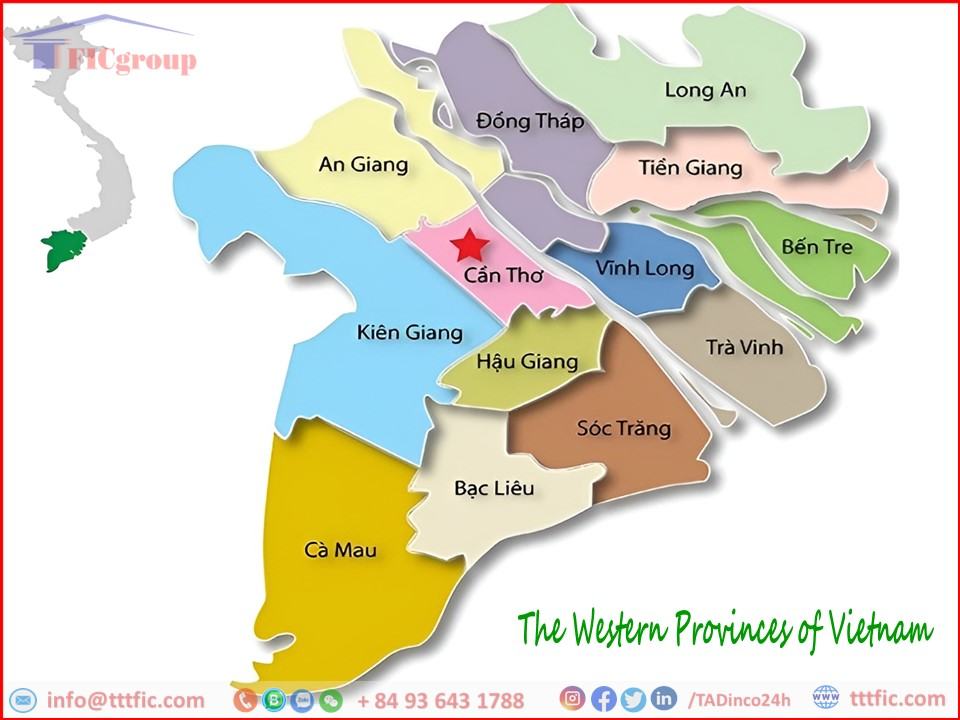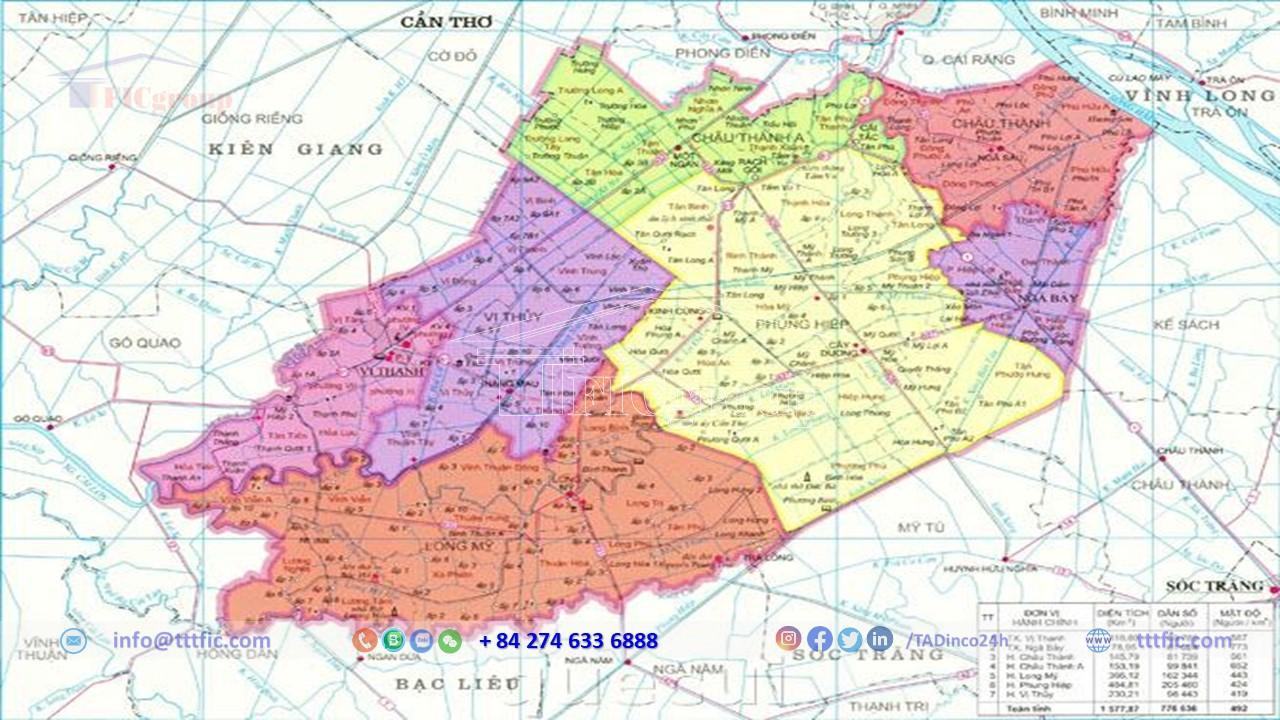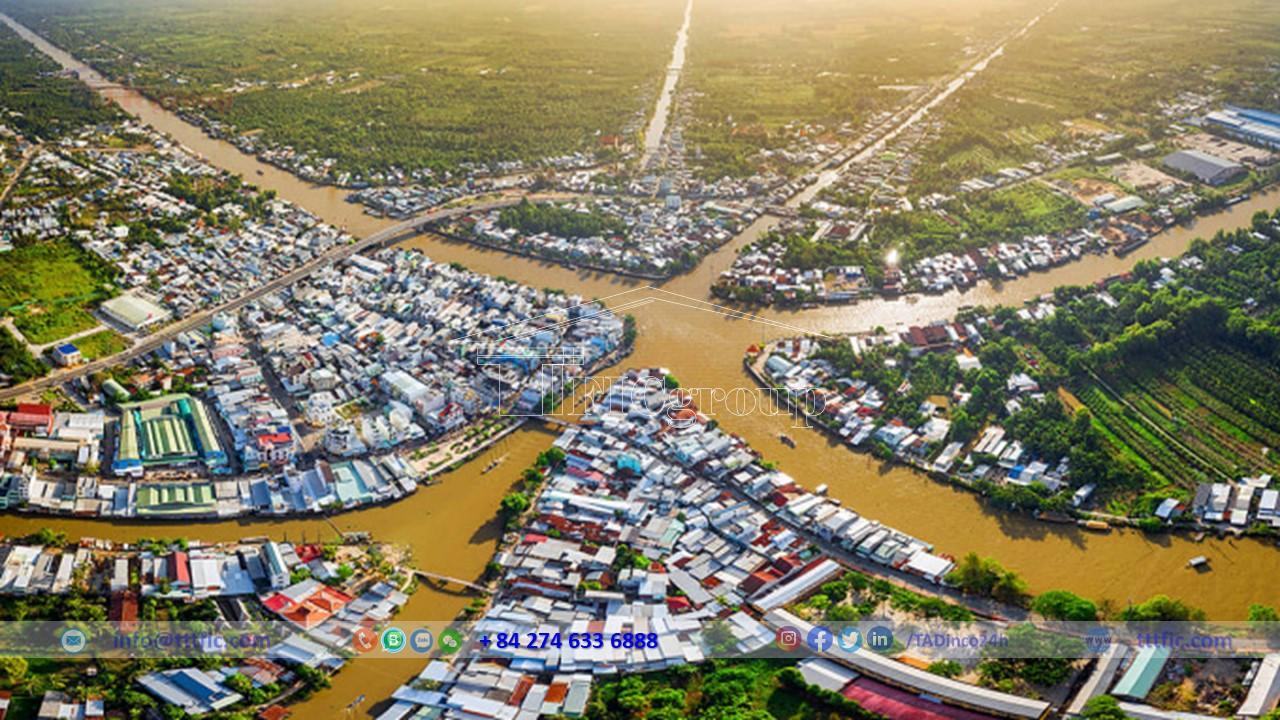Hau Giang Province
Located in the Mekong Delta, Hau Giang Province was established in 2004 when it separated from the old Can Tho Province. Vi Thanh City, the provincial capital, lies 240 km southwest of Ho Chi Minh City and 60 km from Can Tho City along National Highway 61, and it’s just 40 km away on the route connecting it to Can Tho City.

Hau Giang Province – TTTFIC GROUP
Hau Giang sits in the center of the Mekong Delta, being part of its inland area. The Hau River was known as Hau Giang before 1976. Before 1956, the land that now makes up Hau Giang Province was part of Can Tho and Rach Gia Provinces, and from 1957, it belonged entirely to Can Tho Province. In March 1976, the establishment of Hau Giang Province took place by merging three previous provincial-level administrative units: Can Tho Province, Soc Trang Province, and Can Tho City. Hau Giang Province divided into Can Tho Province and Soc Trang Province on December 26, 1991. On November 26, 2003, a further division of Can Tho Province created the centrally-run city of Can Tho and today’s Hau Giang Province.
Being one of the rice production centers of the Southwestern region, Hau Giang Province excels in rice and fruit crops, and it boasts abundant aquatic resources, primarily freshwater shrimp and fish. The Mai Dam River is renowned for its specialty catfish. Notably, the province hosts the Nga Bay floating market and many national historical monuments, including the Nam Ky Uprising Monument, the Southern Resistance Liaison Monument, the Can Tho Provincial Committee Base, the Tam Vu Monument, and Uncle Ho’s Shrine.

Hau Giang Province – TTTFIC GROUP
Geography:
Geographical location:
Situated in the heart of the Mekong Delta, Hau Giang is an inland province that owns a strategic geographical position, with coordinates from 9030’35 to 10019’17 North latitude and from 105014’03 to 106017’57 East longitude. Embraced by several neighboring provinces, Hau Giang borders Soc Trang to the east, Kien Giang to the west, Bac Lieu to the south, and Can Tho city and Vinh Long province to the north.
The province’s administrative center, Vi Thanh city, is conveniently located in relation to other major economic centers. Vi Thanh is 240 km southwest of Ho Chi Minh City, 60 km from Can Tho city along National Highway 61, and only 40 km along the route connecting the two cities. This advantageous geographical position not only opens up economic development opportunities for Hau Giang but also contributes to the unique character of this region.
Natural condition:
Hau Giang is in the Mekong Delta, with an average elevation of less than 2 meters above sea level. Its terrain gradually descends from North to South and East to West, intersected by man-made canals.
Located within the Northern Hemisphere tropics, near the equator, Hau Giang has a tropical monsoon climate, divided into two distinct seasons. The average temperature is 27°C, with minimal annual variation. The rainy season runs from May to November, with an average annual rainfall of about 1800mm. The average relative humidity is 82%.
Its river network is extensive, with a total length of approximately 2,300 km. The river density is 1.5 km/km, reaching up to 2 km/km in Chau Thanh district. Hau Giang has two structural layers: the lower layer consists of Granite and crystalline rocks; the upper layer consists of marine sedimentary rocks, continental rocks, and intrusive or extrusive igneous rocks.
Economy:
Agriculture: The province is a major rice production hub, contributing significantly to Vietnam’s status as one of the world’s largest rice exporters. Additionally, it excels in fruit crops and boasts abundant aquatic resources, primarily freshwater shrimp and fish.
Aquaculture: The presence of a rich network of rivers and canals supports a thriving aquaculture industry, with major products including catfish and shrimp.
Trade and Commerce: Hau Giang is known for its floating markets, with the Nga Bay market being a significant local economic and tourism hub. These markets are crucial for local trade, especially agricultural and aquaculture products.
Tourism: While not as well-known as other destinations in Vietnam, Hau Giang has several historical monuments and natural attractions that draw domestic and international tourists.
Infrastructure Development: As of the last update, efforts were ongoing to improve the province’s infrastructure to facilitate economic growth, including road and bridge construction, and improving irrigation systems for agriculture and aquaculture.

Hau Giang Province – TTTFIC GROUP
Social:
Education:
The province of Hau Giang in Vietnam has a comprehensive education system, including preschools, primary, secondary, and high schools, as well as vocational, college, and university institutions. However, the demand for preschool education still outweighs the supply. As of 30th September 2008, there were 250 schools at various levels in Hau Giang, ranking 12th in the Mekong Delta region.
Healthcare system
The healthcare system in Hau Giang includes multiple hospitals such as the Hau Giang General Hospital, Hau Giang Obstetrics and Pediatrics Hospital, Vi Thanh City Hospital, Hau Giang Psychiatric Hospital, Hau Giang Tuberculosis Hospital, and many other medical facilities in communes and towns. As of 2008, there were 80 medical examination and treatment facilities directly under the Department of Health, including 8 hospitals, 8 regional general clinics, and 64 commune health stations.
Population:
Regarding the population, the average population in 2021 of Hau Giang province was 729,888 people, an increase of 108 people or 0.01% compared to 2020. The province’s population consists of multiple ethnic groups. As of October 2009, Hau Giang had 7,533 households of ethnic minorities, accounting for 3.16% of the population, the most numerous of which were the Khmer with 5,537 households and 25,536 individuals.
In terms of religion, as of April 1, 2019, there were 11 different religions in the province with 152,031 followers, the most being Buddhism with 116,996 followers.
Hau Giang also has diverse and rich traditional crafts, reflecting the unique culture of the land and its people. Many people favor the province’s special fruit trees, such as Cau Duc pineapples, Phu Huu grapefruits, and Long Tri sugar oranges. People know Hau Giang for its seafood specialty, the Vi Thanh featherback fish, which is famous throughout the Mekong Delta. The province also has many cultural relics and historical.
Overall, Hau Giang province is rich in culture, education, healthcare, and population diversity.



